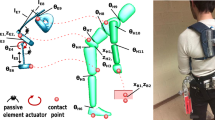Abstract
Industrial workers still face work-related musculoskeletal disorders daily and therefore physical support systems like exoskeletons are being developed. Making these wearable robots adaptable to different tasks and users in terms of its support characteristics is expected to generate greater performance and broader acceptance. By analyzing relevant elements of joint tasks in groups of humans and the environment exoskeletons are typically being used in, this paper derives the need for a framework allowing for adaption of the exoskeleton to the task, but also predictability for the user of the exoskeleton. A situation aware gain-scheduling controller with internal state feedback to the user is proposed as a means for adaption and predictability.
Access this chapter
Tax calculation will be finalised at checkout
Purchases are for personal use only
Similar content being viewed by others
References
Bogue, R.: Exoskeletons – a review of industrial applications. Industrial Robot: An Intern. J. 45(5), 585–590 (2018)
Fox, S., Aranko, O.: Exoskeletons: Comprehensive, comparative and critical manufacturing performance. J. Manuf. Technol. Manag. (2019)
de Looze, M.P., Bosch, T., Krause, F., Stadler, K.S., O’Sullivan, L.W.: Exoskeletons for industrial application and their potential effects on physical work load. Ergo 59, 1–11 (2016)
Hoffmann, N., Argubi-Wollesen, A., Linnenberg, C., Weidner, R.: Towards a Framework for Evaluating Exoskeletons. In: Production at the Leading Edge of Technology, pp. 441–450. Springer, Berlin (2019)
Weidner, R., Kong, N., Wulfsberg, J.P.: Human hybrid robot: a new concept for supporting manual assembly tasks. Prod. Eng. 7(6), 675–684 (2013)
Weidner, R., Karafillidis, A.: Distinguishing support technologies. A general scheme and its application to exoskeletons. In: Karafillidis, A., Weidner, R. (eds.) Developing Support Technologies, pp. 85–100. Springer, Cham (2018)
Otten, B., Weidner, R., Argubi-Wollesen, A.: Evaluation of a novel active exoskeleton for tasks at or above head level. IEEE Robot. Autom. Lett. 3(3), 2408–2415 (2018)
Argubi-Wollesen, A., Weidner, R.: Biomechanical analysis: adapting to users’ physiological preconditions and demands by the use of biomechanical analysis. In: Karafillidis, A., Weidner, R. (eds.) Developing Support Technologies, pp. 47–62. Springer, Cham (2018)
Maurice, P., Ivaldi, S., Babic, J., Camernik, J., Gorjan, D., Schirrmeister, B., Bornmann, J., Tagliapietra, L., Latella, C., Pucci, D., Fritzsche, L., Ivaldi, S., Babic, J.: Objective and subjective effects of a passive exoskeleton on overhead work. IEEE Trans. Neural. Syst. Rehabil. Eng. 28(1), 152–164 (2020)
Spada, S., Ghibaudo, L., Gilotta, S., Gastaldi, L., Cavatorta, M.P.: Investigation into the applicability of a passive upper-limb exoskeleton in automotive industry. Procedia Manuf. 11, 1255–1262 (2017)
Amandels, S., Op het Eyndt, H.O., Daenen, L., Hermans, V.: Introduction and testing of a passive exoskeleton in an industrial working environment. Adv. Intell. Syst. Comput. 820, 387–392 (2019)
Baltrusch, S.J., van Dieën, J.H., van Bennekom, C.A.M., Houdijk, H.: The effect of a passive trunk exoskeleton on functional performance in healthy individuals. Appl. Ergon. 72, 94–106 (2018)
Chen, B., Grazi, L., Lanotte, F., Vitiello, N., Crea, S.: A real-time lift detection strategy for a hip exoskeleton. Front. Neurorobot. 12, 1–11 (2018)
Lockheed Martin. Homepage https://www.lockheedmartin.com/en-us/products/exoskeleton-technologies/industrial.html. Acessed 28 March 2020
Van Engelhoven, L., Kazerooni, H.: Design and intended use of a passive actuation strategy for a shoulder supporting exoskeleton. In: WearRAcon, pp. 7–12 (2019)
Koopman, A.S., Toxiri, S., Power, V., Kingma, I., van Dieën, J.H., Ortiz, J., de Looze, M.P.: The effect of control strategies for an active back-support exoskeleton on spine loading and kinematics during lifting. J. Biomech. 91, 14–22 (2019)
Yao, Z., Linnenberg, C., Weidner, R., Wulfsberg, J.P.: Development of a soft power suit for lower back assistance. Proceedings of the IEEE International Conference on Robotics and Automation, pp. 5103–5109 (2019) (2019)
Mason, M.T.: Toward robotic manipulation. Annu. Rev. Cont. Robot. Auton. Syst. 1(19), 1–28 (2018)
Sebanz, N., Knoblich, G.: Prediction in joint action: what, when, and where. Top. Cogn. Sci. 1, 353–367 (2009)
Vesper, C., van der Wel, R.P., Knoblich, G., Sebanz, N.: Are you ready to jump? Predictive mechanisms in interpersonal coordination. J. Exp. Psychol. Hum. Percept. Perform. 39(1), 48–61 (2013)
van der Steen, M.C., Keller, P.E.: The ADaptation and Anticipation Model (ADAM) of sensorimotor synchronization. Front. Hum. Neurosci. 7, 253 (2013)
Peternel, L., Noda, T., Petrič, T., Ude, A., Morimoto, J., Babič, J.: Adaptive control of exoskeleton robots for periodic assistive behaviours based on EMG feedback minimisation. PLoS One 11(2), 1–26 (2016)
Knoblich, G., Jordan, J.S.: Action coordination in groups and individuals: learning anticipatory control. J. Exp. Psychol. Learn. Mem. Cogn. 29(5), 1006–1016 (2003)
Huang, C.M., Mutlu, B.: Anticipatory Robot Control for Efficient Human-Robot Collaboration. In: ACM/IEEE International Conference on Human-Robot Interaction, pp. 83–90 (2016)
Lobo-Prat, J., Kooren, P.N., Stienen, A.H., Herder, J.L., Koopman, B.F.J.M., Veltink, P.H.: Non-invasive control interfaces for intention detection in active movement-assistive devices. J. Neuroeng. Rehabil. 11(168), 1–22 (2014)
Bances, E., Schneider, U., Siegert, J.T.B.: Exoskeletons towards industrie 4.0: benefits and challenges of the IoT communication architecture. Procedia Manuf. 42, 49–56 (2020)
Ajoudani, A., Zanchettin, A.M., Ivaldi, S., Albu-Schäffer, A., Kosuge, K., Khatib, O.: Progress and prospects of the human–robot collaboration. Auton. Robots 42, 957–975 (2018)
Acknowledgements
Parts of this research are funded by the Federal Ministry of Education and Research (BMBF) in the project “smart ASSIST – Smart, Adjustable, Soft and Intelligent Support Technologies” (funding number 16SV71114) and “Exo@Work - Influences of Exoskeletons on the workplace” (funded by the German employers’ liability insurance association (BGHW)). The authors are solely responsible for the manuscript content.
Author information
Authors and Affiliations
Corresponding author
Editor information
Editors and Affiliations
Rights and permissions
Copyright information
© 2021 The Author(s), under exclusive license to Springer-Verlag GmbH, DE , part of Springer Nature
About this paper
Cite this paper
Otten, B., Hoffmann, N., Weidner, R. (2021). Towards Adaptive System Behavior and Learning Processes for Active Exoskeletons. In: Behrens, BA., Brosius, A., Hintze, W., Ihlenfeldt, S., Wulfsberg, J.P. (eds) Production at the leading edge of technology. WGP 2020. Lecture Notes in Production Engineering. Springer, Berlin, Heidelberg. https://doi.org/10.1007/978-3-662-62138-7_48
Download citation
DOI: https://doi.org/10.1007/978-3-662-62138-7_48
Published:
Publisher Name: Springer, Berlin, Heidelberg
Print ISBN: 978-3-662-62137-0
Online ISBN: 978-3-662-62138-7
eBook Packages: EngineeringEngineering (R0)




